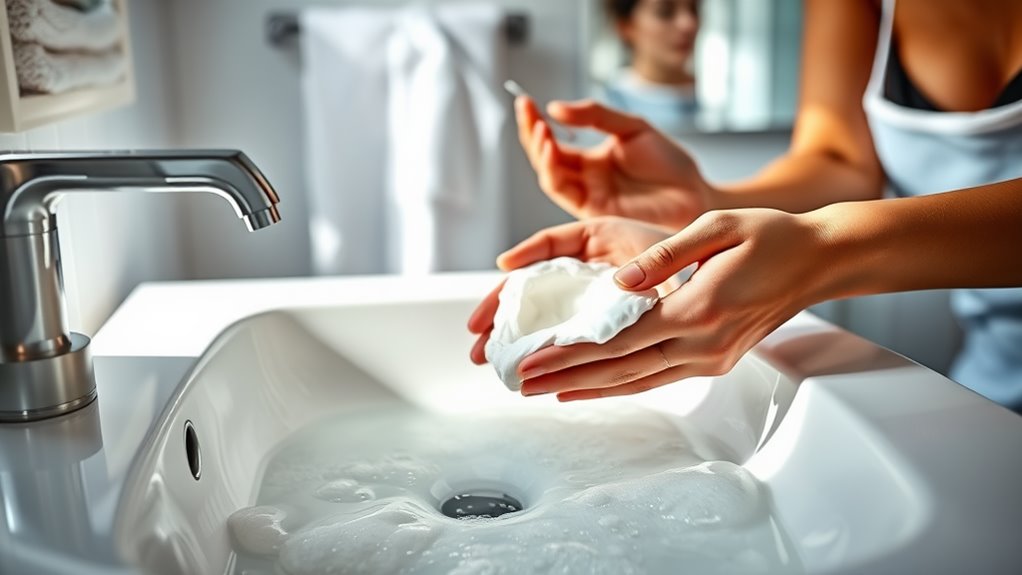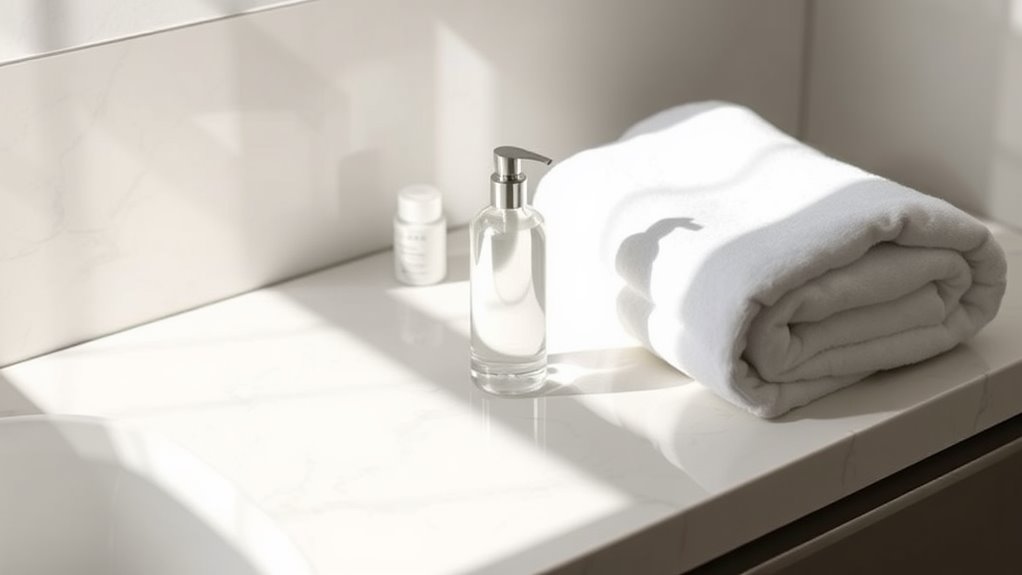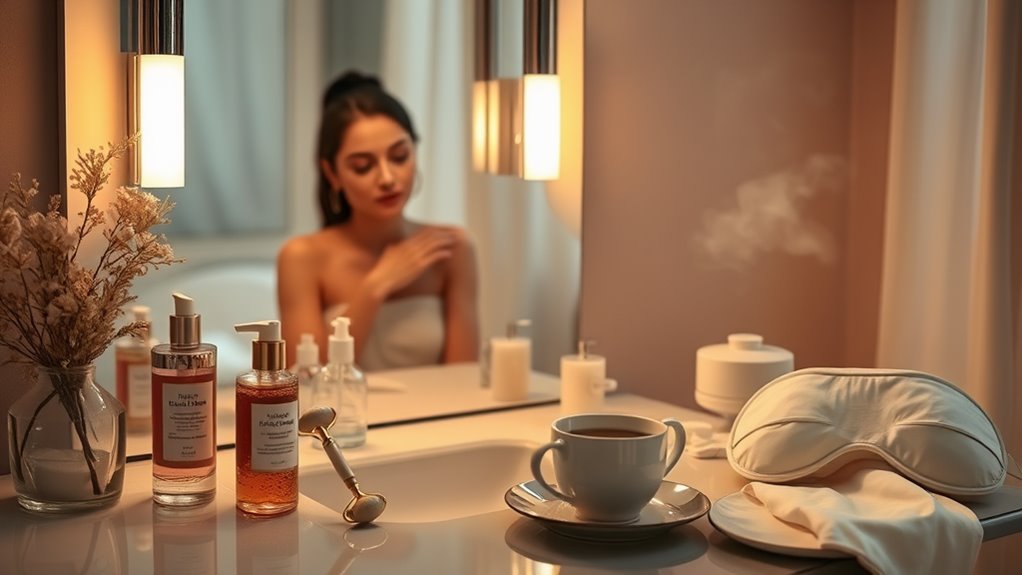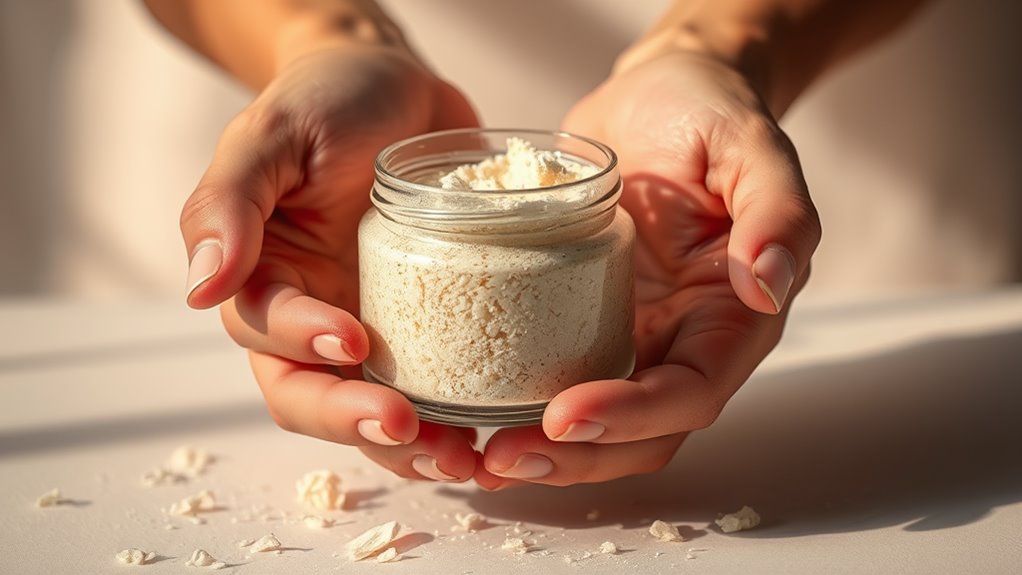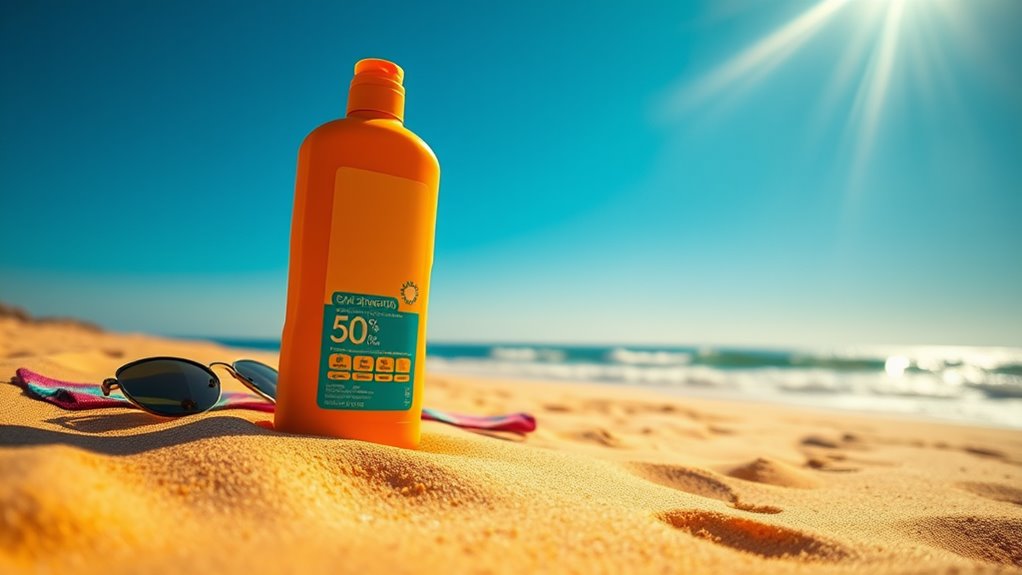You’re Probably Washing Your Face Wrong – Here’s the Right Way
You’re likely washing your face wrong, which can harm your skin. Using hot or cold water disrupts your skin’s barrier, while harsh cleansers strip essential oils. You should identify your skin type to choose the right cleanser and use lukewarm water for optimal cleansing. Gentle circular motions are best, and patting, rather than rubbing, keeps your skin protected. By adjusting your cleansing technique, you can achieve a healthier complexion—there’s more to perfecting your routine.
Key Takeaways
- Use lukewarm water around 98 to 100 degrees Fahrenheit to effectively cleanse without irritating the skin’s natural barrier.
- Choose a cleanser suitable for your skin type: gel for oily, cream for dry, and gentle foaming for combination skin.
- Apply cleanser with gentle circular motions for even coverage and minimal irritation, focusing on often-neglected areas like the jawline.
- Rinse thoroughly with lukewarm water for at least 30 seconds to ensure complete removal of cleanser and impurities.
- Pat your face dry with a clean towel, avoiding rubbing to minimize irritation and support skin hydration.
The Importance of Proper Face Washing
Proper face washing is crucial for maintaining healthy skin and preventing a range of dermatological issues. When you wash your face correctly, you remove dirt, oil, and impurities that can clog pores and lead to breakouts.
To achieve optimal results, follow essential face washing tips. Start with lukewarm water, as it effectively dissolves grime without irritating your skin. Use a gentle, pH-balanced cleanser tailored to your skin type, applying it with circular motions.
Rinse thoroughly to ensure no residue remains, which can cause irritation. Don’t forget to pat your face dry with a clean towel, as rubbing can exacerbate skin issues. Additionally, incorporating effective techniques into your routine will enhance your skin’s health and appearance significantly.
Incorporating these practices into your routine will enhance your skin’s health and appearance significantly.
Common Mistakes People Make
Many people unknowingly overuse cleansers, believing that more product leads to better results. Additionally, using water that’s too hot or too cold can disrupt your skin’s natural barrier. Recognizing these common mistakes can significantly improve your skincare routine. Using excessive cleansers can strip the skin of its natural oils, leading to dryness and irritation.
Overusing Cleansers
While it might seem beneficial to cleanse your face multiple times a day, overusing cleansers can disrupt your skin’s natural barrier. Each time you wash your face, you strip away oils that maintain hydration and protection.
This excessive cleansing can lead to dryness, irritation, and even exacerbate conditions like acne. Your skin requires a balanced approach; typically, cleansing twice a day—once in the morning and once at night—is sufficient for most skin types.
If you engage in heavy sweating or wear makeup, consider a gentle cleanser for those instances, rather than frequent full washes. Remember, the goal is to maintain skin health, not strip it away.
Adjust your routine to promote a resilient, well-balanced complexion.
Incorrect Water Temperature
Using the wrong water temperature when washing your face can significantly impact your skin’s health.
Hot water can strip your skin of its natural oils, leading to dryness and irritation. Conversely, cold water may not effectively dissolve dirt and oil, preventing thorough cleansing. The ideal temperature is lukewarm—this balances efficacy and comfort.
Lukewarm water helps open pores, allowing your cleanser to penetrate more deeply, while minimizing the risk of damage. After cleansing, rinse with cool water to help close pores and lock in moisture.
Choosing the Right Cleanser
How do you determine the best cleanser for your skin type? Start by identifying your skin’s specific needs: is it oily, dry, combination, or sensitive?
For oily skin, look for gel-based cleansers with salicylic acid to control excess sebum. If your skin is dry, opt for cream-based cleansers with hydrating ingredients like glycerin or hyaluronic acid to maintain moisture levels.
For combination skin, consider a gentle foaming cleanser that balances both oiliness and dryness. Sensitive skin requires fragrance-free, hypoallergenic formulas to minimize irritation.
Always check the pH level; ideally, it should be between 4.5 and 6.5 to maintain skin barrier integrity. Finding the perfect cleanser is essential for optimizing your skincare routine.
Lastly, test the cleanser on a small area to ensure compatibility before full application.
The Perfect Water Temperature
What temperature should you use when washing your face? Ideally, lukewarm water is your best bet.
Water that’s too hot can strip your skin of essential oils, leading to dryness and irritation. Conversely, cold water may not effectively remove dirt and oil, leaving your pores clogged.
Aim for a temperature around 98 to 100 degrees Fahrenheit. This range is close to your skin’s natural temperature, promoting optimal cleansing without causing damage.
Lukewarm water helps to open pores, allowing your cleanser to penetrate more effectively, while also maintaining skin hydration. Additionally, using the right temperature can prevent cleansing mistakes that may harm your skin barrier.
How to Wet Your Face Correctly
When you wet your face, it’s essential to ensure even coverage and avoid harsh impacts on your skin.
Start by splashing lukewarm water onto your face, using your hands to guide the water across all areas. This method promotes gentle hydration while preventing temperature shock.
Avoid using high-pressure streams from faucets, as they can disrupt your skin’s natural barrier. Instead, consider cupping your hands to collect water and applying it in a controlled manner.
Focus on areas often neglected, such as your jawline and hairline, to ensure full coverage. Aim for about 30 seconds of gentle wetting to allow your skin to absorb moisture effectively, setting the stage for optimal cleansing. Additionally, remember that gentle cleansing is crucial for maintaining skin hydration and preventing over-drying.
The Right Technique for Application
To effectively wash your face, start with proper hand preparation to eliminate bacteria.
Applying the cleanser using gentle circular motions ensures even coverage and minimizes irritation.
Finally, rinse with lukewarm water to remove impurities without stripping your skin’s natural oils.
Proper Hand Preparation
Before you begin washing your face, ensuring your hands are properly prepared is crucial for effective cleansing. Start by thoroughly washing your hands with soap and water for at least 20 seconds to eliminate bacteria and dirt.
Pay special attention to the areas between your fingers and under your nails. After rinsing, dry your hands with a clean towel or allow them to air dry to avoid reintroducing contaminants.
If you’re using a moisturizer or treatment, ensure your hands are free of any residual products that could interfere with the cleansing process.
This meticulous hand preparation sets the foundation for optimal product application and enhances the overall effectiveness of your facial cleansing routine.
Gentle Circular Motions
Gently massaging your face in circular motions during cleansing enhances the effectiveness of your skincare routine. This technique not only promotes blood circulation but also ensures thorough product absorption.
To master this method, follow these steps:
-
Start at the center: Begin at your forehead, moving in small circles outward.
-
Focus on each area: Spend a few seconds on your cheeks, chin, and nose, maintaining a gentle touch.
-
Use consistent pressure****: Apply enough pressure to stimulate the skin without causing irritation.
-
Incorporate upward motions****: Always move upward to counteract gravity, helping to lift and firm the skin.
Rinse With Lukewarm Water
After effectively massaging your face with circular motions, rinsing with lukewarm water is vital for removing cleanser residues and impurities. Lukewarm water ensures that your skin’s natural oils remain intact while facilitating the removal of dirt and makeup. This temperature also enhances blood circulation, promoting a healthy glow.
| Benefits of Lukewarm Water | Effects on Skin |
|---|---|
| Maintains moisture balance | Reduces irritation |
| Enhances absorption | Improves elasticity |
| Promotes circulation | Soothes redness |
To rinse, tilt your head slightly backward and let the water flow over your face. This technique prevents water from entering your eyes and allows an even cleanse. Always follow with a gentle pat dry using a clean towel for optimal results.
The Importance of Timing
Timing plays a crucial role in the effectiveness of your facial cleansing routine, as the skin’s condition changes throughout the day.
To optimize your face washing, consider these four key times:
-
Morning: Cleansing helps remove excess oil and sweat accumulated overnight, prepping your skin for the day ahead.
-
After Exercise: Post-workout, sweat and bacteria can clog pores; timely cleansing prevents breakouts.
-
Evening: Washing off pollutants and makeup is vital to allow your skin to repair and regenerate overnight.
-
Before Special Events: A pre-event cleanse can enhance your skin’s radiance, ensuring a fresh appearance.
Rinsing: How to Do It Right
When rinsing your face, using warm water is crucial for effectively removing impurities.
The duration of your rinse also plays a significant role in ensuring that all cleansing agents are washed away.
Finally, employing the right technique can enhance your rinsing process, leading to clearer skin.
Importance of Warm Water
Using warm water to rinse your face plays a crucial role in effective skincare. It not only enhances cleansing but also prepares your skin for absorption of products. Here’s why it matters:
-
Opens Pores: Warm water dilates pores, making it easier to remove dirt, oil, and impurities.
-
Enhances Circulation: The warmth increases blood flow, promoting healthier skin appearance.
-
Improves Product Efficacy: Rinsing with warm water helps active ingredients penetrate deeper for better results.
-
Balances Oil Production: It helps regulate sebum production, preventing excessive dryness or oiliness.
Incorporating warm water into your routine can significantly elevate your skincare game, ensuring your skin receives the care it deserves.
Rinse Duration Matters
Proper rinsing is just as important as the temperature of the water you use. The duration of your rinse impacts your skin’s health significantly.
Ideally, you should rinse your face for at least 30 seconds to ensure complete removal of cleanser residue and impurities. Insufficient rinsing can leave behind microns of product, potentially leading to clogged pores, irritation, or breakouts.
Additionally, longer rinsing helps to ensure that the skin’s pH balance is restored, preventing dryness and promoting optimal hydration. Focus on consistent, gentle rinsing rather than rushing the process.
Technique for Effective Rinsing
To achieve effective rinsing, it’s essential to adopt a methodical approach that maximizes the removal of cleanser and impurities. Follow these steps to ensure a thorough rinse:
-
Use lukewarm water**** – It effectively dissolves products without irritating your skin.
-
Rinse in sections – Start with your forehead, then your cheeks, nose, and chin, ensuring all areas are covered.
-
Employ a gentle motion**** – Use your fingertips to guide water across your face, promoting circulation while removing residues.
-
Double-check for residue – After rinsing, gently pat your skin with a clean towel, ensuring no cleanser remains.
Exfoliation: When and How Often
While exfoliation is essential for maintaining healthy skin, knowing when and how often to do it can significantly impact your complexion. Generally, you should exfoliate 1-3 times a week, depending on your skin type and the exfoliant used. Sensitive skin benefits from lighter exfoliation, while oily skin may tolerate more frequent treatments.
| Skin Type | Recommended Exfoliation Frequency | Type of Exfoliant |
|---|---|---|
| Sensitive | Once a week | Gentle chemical |
| Normal | 1-2 times a week | Physical or chemical |
| Oily | 2-3 times a week | Stronger chemical |
Consistency is crucial. Over-exfoliating can lead to irritation, so pay attention to how your skin responds after each session.
Patting vs. Rubbing: The Drying Process
When drying your face, the method you choose can significantly affect your skin’s health. Rubbing your skin can lead to irritation, while patting is gentler and promotes better moisture retention.
Here’s why you should favor patting over rubbing:
-
Minimizes Irritation: Patting reduces friction on the skin, lowering the risk of redness and inflammation.
-
Enhances Hydration: This technique allows residual moisture to seep into your skin, improving hydration levels.
-
Promotes Circulation: Gentle patting can stimulate blood flow, contributing to a healthier complexion.
-
Supports Skin Barrier: A softer approach helps maintain your skin’s natural barrier, preserving its protective functions.
Incorporating Other Skincare Products
Incorporating other skincare products into your routine can enhance the benefits of washing your face, ensuring your skin remains healthy and well-nourished.
After cleansing, consider applying a toner to restore pH balance and remove residual impurities. Following this, serums rich in active ingredients—like hyaluronic acid or retinol—target specific skin concerns, such as dryness or aging.
Moisturizers trap hydration, while those with occlusive agents can lock in moisture effectively. Don’t forget sunscreen during the day; it’s crucial for protecting against UV damage.
When layering products, apply from thinnest to thickest for optimal absorption. Each product’s formulation should complement your skin type, maximizing effectiveness and preventing irritation.
Tailoring your regimen in this way fosters a balanced, resilient complexion.
Establishing a Consistent Routine
Establishing a consistent skincare routine is essential for achieving and maintaining healthy skin, as it allows your complexion to adapt to the products and techniques you use.
To master your routine effectively, follow these key steps:
-
Cleanse Twice Daily: Use a gentle cleanser in the morning and evening to remove impurities.
-
Exfoliate Regularly: Incorporate exfoliation 1-3 times a week to promote cell turnover and enhance product absorption.
-
Moisturize Appropriately: Choose a moisturizer that suits your skin type to maintain hydration and barrier function.
-
Apply Sunscreen Daily: Protect your skin from UV damage with a broad-spectrum sunscreen every morning.
